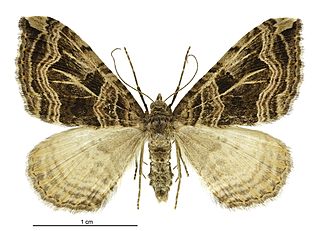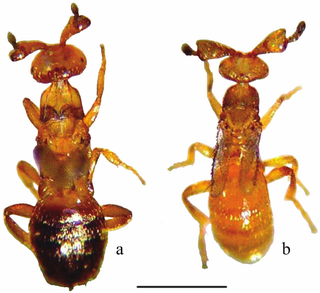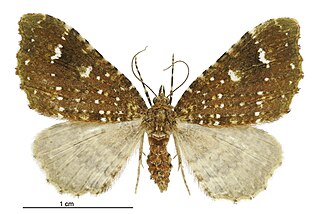
The Drepanidae are a family of moths with about 660 species described worldwide. They are generally divided in three subfamilies) which share the same type of hearing organ. Thyatirinae, previously often placed in their own family, bear a superficial resemblance to Noctuidae. Many species in the drepanid family have a distinctively hook-shaped apex to the fore wing, leading to their common name of hook-tips.
Calamoecia australica is a species of calanoid copepod in the family Centropagidae.
Calamoecia is a genus of copepods in the family Centropagidae confined to Australasia. It is thought to have evolved since the separation of the Australian continent from Antarctica. Three of the Australian endemic species are listed as vulnerable species on the IUCN Red List. The genus contains the following species:

Xanthorhoe semifissata, commonly known as the Barred Pink Looper, is a moth of the family Geometridae. It is endemic to New Zealand and is found throughout the country although it is much less common in the mountains in the south and west of the South Island. The larvae host plants include Nasturtium officinale as well as species in the Cardamine genus. Adult moths inhabit shrubs at the edge of native forest.

Palpita is a genus of moths of the family Crambidae. Members of the moth genus Stemorrhages may be very similar in appearance.

Melittobia is a genus of hymenopteran insects of the family Eulophidae.

The Helosciomyzidae are a small family of flies - 9 genera and 22 species. All are known from the Southern Hemisphere. With the exception of the South American genus Sciogriphoneura, the family occurs in Australia, New Zealand. Little is known of their biology.

Methyl phenkapton is an organophosphorus compound. It is highly toxic.

Helastia cinerearia is a moth of the family Geometridae. It is endemic to New Zealand.
Hypsidia is a genus of moths belonging to the subfamily Thyatirinae of the Drepanidae. It was described by Walter Rothschild in 1896.
Hypsidia grisea is a moth in the family Drepanidae. It was described by Malcolm J. Scoble and Edward David Edwards in 1988. It is found in Australia.
Hypsidia microspila is a moth in the family Drepanidae. It was described by Alfred Jefferis Turner in 1942. It is found in Australia.
Hypsidia niphosema is a moth in the family Drepanidae. It was described by Oswald Bertram Lower in 1908. It is found in Australia.
Hypsidia erythropsalis is a moth in the family Drepanidae. It was described by Walter Rothschild in 1896. It is found in Australia, where it has been recorded from northern Queensland. The habitat consists of rainforests.
Hypsidia robinsoni is a moth in the family Drepanidae. B.S. Hacobian described it in 1986. It is found in Australia, where it has been recorded from northern Queensland.
Gnathifera is a genus of moths in the family Epermeniidae.

Ochromolopis is a genus of moths in the family Epermeniidae described by Jacob Hübner in 1824.
Gnathifera australica is a moth in the family Epermeniidae. It was described by Reinhard Gaedike in 1968. It is found in Australia, where it has been recorded from New South Wales.

Asaphodes imperfecta is a moth in the family Geometridae. It is endemic to New Zealand and is found in the southern part of the South Island. The species inhabits low lying swampy native forest. The host plants of the larvae of this species is unknown. The adults are on the wing in December and January. It is classified as critically endangered by the Department of Conservation.

Asaphodes limonodes is a species of moth in the family Geometridae. It is endemic to New Zealand and is found in both the North and South Islands. This species inhabits damp native forest. Adults are on the wing from November until March.









